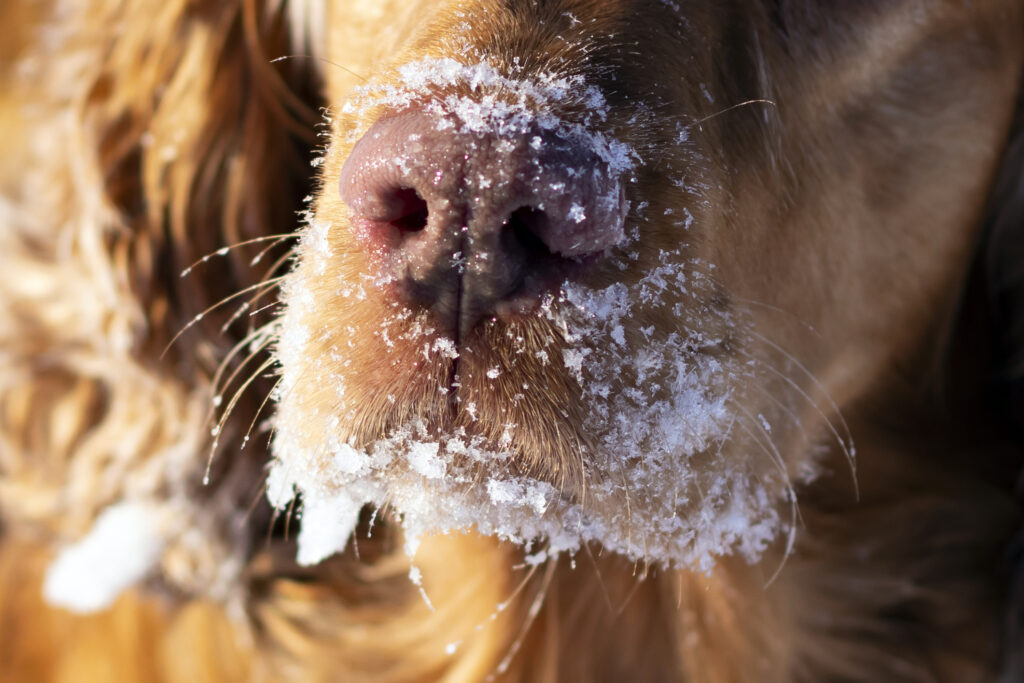Snow Nose in Dogs: What Is It and Why Does It Happen?

Photo by Ekaterina Sheshina/iStock/Getty Images Plus
If your dog’s normally dark nose turns pink during the colder months, they may have a harmless condition called snow nose.
However, snow nose in dogs can be mistaken for more serious health problems, so it’s important to know what sets a dog with snow nose apart from a pink-nosed dog who needs to see a veterinarian.
Key Takeaways
- Snow nose is a harmless cosmetic condition where a dog’s nose lightens in color, often during winter.
- The condition doesn’t require treatment and may resolve as temperatures rise—though some dogs keep the lighter color year-round.
- If your dog’s nose also develops sores, bleeding, or discomfort, it could be a sign of a more serious issue that needs veterinary attention.
What Is Snow Nose in Dogs?
Snow nose in dogs (also known as winter nose or seasonal nasal hypopigmentation) is a benign (harmless) condition where a dog’s nose loses some or all its pigmentation and turns a lighter color.
This phenomenon occurs most frequently during winter months, though it can also appear year-round and in warmer climates.
The appearance of snow nose is quite distinctive. A dog’s nose will usually turn pink or light brown. The entire nose may be affected, but often a lighter strip will develop down the middle, or only the top fades.
The good news is that snow nose is purely cosmetic and poses no health risks. However, you should contact your veterinarian if your dog’s nose develops:
- Texture changes
- Excessive dryness
- Sores
- Bleeding
- Crusting
- Discomfort
These symptoms are not seen with snow nose and could indicate a more serious condition such as discoid lupus erythematosus, infection, or cancer.
Symptoms of Snow Nose in Dogs
The only symptom associated with snow nose in dogs is a noticeable lightening of nose pigmentation. The dog’s nose was previously a normal darker color, but now some or all it has become lighter.
Importantly, true snow nose affects only the color of the nose—everything else remains perfectly normal.
Sometimes a dog’s nose returns to its original color as temperatures warm, but in other cases, the change can be permanent.
How Do Dogs Get Snow Nose?
The exact cause of snow nose isn’t known, but despite its name, exposure to snow isn’t required.
It’s possible that less melanin—the pigment that makes skin and hair brown—is produced because certain enzymes are less active in cold or low-light conditions on the exposed skin of a dog’s nose.
The truth is, not much research has been done on snow nose because it isn’t a medical concern.
We do know that certain breeds are predisposed to snow nose, suggesting that genetics play a role. The most affected breeds include:
However, dogs of any breed, sex, or age can develop snow nose.
Treatment of Snow Nose in Dogs
No treatment is necessary for snow nose in dogs because it’s a completely harmless, cosmetic condition. People have tried various remedies, but none have proven effective.
In many cases, a dog nose turning pink resolves naturally as temperatures rise and sunlight exposure increases in spring and summer. The condition can be cyclical, with pigment fading during colder months and returning when it’s warm—though not always. Even when a dog’s snow nose becomes permanent, it remains a purely cosmetic change that doesn’t require treatment.
If you’re concerned about your dog’s nose color fading or turning pink, monitor for other symptoms. If the nose maintains its normal cobblestone texture and doesn’t develop any abnormalities, there’s no need for concern.
Talk to your veterinarian if you have any questions.
How To Prevent Snow Nose in Dogs
Since the cause of snow nose isn’t known, there’s no proven way to prevent it.
Some pet parents wonder if keeping dogs warm in winter might help, but there’s no evidence that temperature or clothing prevent snow nose. Similarly, dietary supplements and topical treatments haven’t been shown to make a difference.
The best approach is simply to accept snow nose as a natural, harmless variation in your dog’s appearance.
Of course, your dog might appreciate a warm winter coat or a heated dog pad when temperatures drop, even if it doesn’t affect their snow nose.
Recommended Products
Regular veterinary checkups will help ensure that any potential problems are caught early, so you can enjoy your adorable pink–nosed pup without worry.
FAQs About Snow Nose in Dogs
Does a snow nose hurt dogs?
No, snow nose doesn’t hurt dogs at all.
The condition is completely painless and purely cosmetic, affecting only pigmentation without causing discomfort, itching, or harm. If your dog has other symptoms such as pain or sores, that could signal another condition requiring veterinary attention.
What breeds have a snow nose?
While any breed can develop snow nose, it most commonly affects Siberian Huskies, Golden Retrievers, Labrador Retrievers, and Bernese Mountain Dogs.
What causes a snow nose?
The exact cause of snow nose hasn’t been identified. Experts believe genetics and reduced melanin production play roles, but little research has been done on this benign condition.
Can a snow nose be permanent?
Yes. While many dogs’ noses return to their darker color when the weather warms, some retain the lighter pigmentation year-round.





